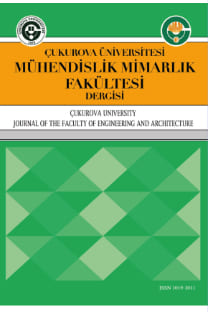Environmental Risk Analysis of Turkey under Climate Change Scenarios using Spatial Modelling: Application of Net Primary Productivity
İklim Değişikliği Senaryoları Altında Konumsal Modelleme Kullanarak Türkiye'nin Çevresel Risk Analizi: Net Birincil Üretim Örneği
___
1.Wang,L., Gong, W., Ma,Y., Zhang,M., 2013. Modeling Regional Vegetation NPP Variations and Their Relationships with Climatic Parameters in Wuhan, China, Earth Interactions, Volume 17, Paper No. 4, p.20.2.Australian Government, 2014. Department of the Environment, Representative Concentration Pathways (RCPs) Fact Sheet.
3.Colak,A.H., Kırca,S., Rotherham,I.D., Ince,A.,2010. Restoration and Rehabilitation of Deforestedand Degraded Forest Landscapes in Turkey,Ministry of Environment and Forestry-General Directorate of Afforestation and Erosion Control (AGM), Ankara, ISBN: 978-605-393-049-5, 566.
4.Anonymous, AGM Activities,2008. Republic of Turkey, Ministry of Environment and Forestry General Directorate of Afforestation and Erosion Control, Ankara.
5.Hijmans,R.J., Cameron,S.E., Parra,J.L., Jones,P.G.,Jarvis,A., 2005. Very High Resolution Interpolated Climate Surfaces for Global Land Areas,International Journal of Climatology 25: 1965-1978.
6.Worldclim Climate Layers Web Page, http://www.worldclim.org/, 2013.
7.Gobron,N., Pinty,B., Verstraete,M.M., Widlowski,J.L., 2000. Advanced Vegetation Indices Optimized for Up-coming Sensors: Design, Performanceand Applications,IEEE Transactions on Geoscience and Remote Sensing, 38(6), 2489-2505.
8.Potter,C.S., Klooster,S., Steinbach,M., Tan,P., Kumar,V., Shekhar,S., Nemani,R., Myneni,R., 2003. Global Teleconnections of Climate to Terrestrial Carbon Flux,Journal of Geophysical Research, Vol. 108, NO. D17, 4556, 10 doi:10.1029/2002JD002979.
9.Potter,C.S., Randerson,J.T., Field,C.B., Matson,P.A., Vitousek,P.M., Mooney,H.A., Klooster,S.A., 1993. Terrestrial Ecosystem Production: A Process Model Based on Global Satellite and Surface Data, Global Biogeochem. Cycles, 7, 811-841.
10.Potter,C.S., Klooster,S., Steinbach,M., Tan,P., Sheikarand,S., Carvalho,C., 2004. Understanding Global Teleconnections of Climate to Regional Model 13 Estimates of Amazon Ecosystem Carbon Fluxes,Global Change Biology, 10, 693-703.
11.Knyazikhin,Y., Martonchik,J.V., Myneni,R.B., Diner,D.J., Running,S.W., 1998. Synergistic Algorithm for Estimating Vegetation Canopy Leaf area Index and Fraction of Absorbed Photosynthetically Active Radiation from MODIS and MISR data. Journal of Geophysical Research 103: 32257-32276.
12.NASA, Land Processes Distributed Archive Center Web Site, https://lpdaac.usgs.gov, 2013.
13.Loh,W.Y., 2002. Regression Trees with Unbiased Variable Selection and Interaction Detection, Statistica Sinica, 361-386.
14.Donmez, C., Berberoglu, S., Curran, P.J., 2011. Modelling the Current and Future Spatial Distribution of Net Primary Production in a Mediterranean Watershed, International Journal of Earth Observation and Geoinformation, vol. 6, pp. 336-345.
- ISSN: 1019-1011
- Yayın Aralığı: 4
- Başlangıç: 1986
- Yayıncı: ÇUKUROVA ÜNİVERSİTESİ MÜHENDİSLİK FAKÜLTESİ
BURAK KURŞUN, KORHAN ÖKTEN, Gonca DEDE
Damping and Vibration Behavior of Adhesively Bonded Glass Fiber Reinforced Composite Laminates
ÖMER YAVUZ BOZKURT, ÖZKAN ÖZBEK, MEHMET BULUT
SAMİ ŞİT, Rıza Hasan ÖZÇALIK, ERDAL KILIÇ, Osman DOĞMUŞ, Mahmut ALTUN
Sürtünme Karıştırma Kaynağının Yaşlandırılabilir Parçalar Üzerinde Etkisi
New Regression Models for Predicting the Hamstring Muscle Strength using Support Vector Machines
Boubacar SOW, Mehmet Fatih AKAY, FATİH ABUT, Ebru ÇETİN, İmdat YARIM, Hacer ALAK
Al 2024 Esaslı B4C/SiC Parçacık Takviyeli Hibrit Kompozitlerin TIG Kaynağı ile Birleştirilmesi
Experimental Investigation of Surface Roughness Effect over Wind Turbine Airfoil
KEMAL KOCA, M. Serdar GENÇ, H. Hakan AÇIKEL
Termoplastiklerin Sürtünme Karıştırma Kaynağı ile Birleştirilmesinde Kullanılan Yöntemler
